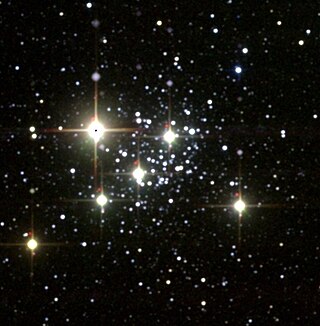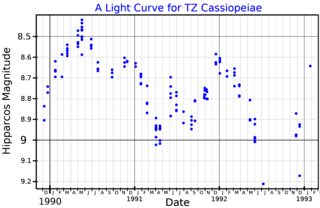
KY Cygni is a red supergiant of spectral class M3.5Ia located in the constellation Cygnus. It is approximately 4,700 light-years away.

BE Camelopardalis is a solitary variable star in the northern circumpolar constellation of Camelopardalis. It is visible to the naked eye as a faint, red-hued point of light with an apparent visual magnitude that fluctuates around 4.39. The star is located roughly 800 light years away from the Sun based on stellar parallax.
KW Sagittarii is a red supergiant star, located approximately 2,160 parsecs away from the Sun in the direction of the constellation Sagittarius. It is one of the largest known stars, with a diameter about 1,000 times larger than the Sun. If placed at the center of the Solar System, the star's surface would engulf Mars, coming close to Jupiter's orbit.

V354 Cephei is a red supergiant star located within the Milky Way. It is an irregular variable located over 13,000 light-years away from the Sun. It has an estimated radius of 1,139 solar radii. If it were placed in the center of the Solar System, it would extend to between the orbits of Mars and Jupiter.

MY Cephei is a red supergiant located in open cluster NGC 7419 in the constellation of Cepheus. It is a semiregular variable star with a maximum brightness of magnitude 14.4 and a minimum of magnitude 15.5.

NO Aurigae is a pulsating variable star in the constellation Auriga. It is an unusually-luminous asymptotic giant branch star about 3,500 light years away.

V602 Carinae is a red supergiant and variable star of spectral type of M3 in the constellation Carina. It is one of largest known stars.

RT Carinae, also known as CD-58 3538, is a red supergiant and a variable star, located 7,000 light years away in the constellation Carina. It is in the Carina Nebula. The average apparent magnitude of +8.55, too faint to be visible to the naked eye.

TZ Cassiopeiae(TZ Cas, HIP 117763, SAO 20912) is a variable star in the constellation Cassiopeia with an apparent magnitude of around +9 to +10. It is approximately 8,400 light-years away from Earth. The star is a red supergiant star with a spectral type of M3 and a temperature around 3,600 K.

T Vulpeculae is a possible binary star system in the northern constellation of Vulpecula, near the star Zeta Cygni, close to the pair 31 Vulpeculae and 32 Vulpeculae. It is visible to the naked eye with an apparent visual magnitude that ranges around 5.75. The distance to this system is around 1,900 light years, as determined from its annual parallax shift of 1.67 mas.

SV Vulpeculae is a classical Cepheid variable star in the constellation Vulpecula. It is a supergiant at a distance of 8,700 light years.

TV Geminorum is a variable red supergiant in the constellation Gemini. Its visual magnitude varies from 6.3 to 7.5.

BC Cygni is a red supergiant and pulsating variable star of spectral type M3.5Ia in the constellation Cygnus.

RW Cygni is a semiregular variable star in the constellation Cygnus, about a degree east of 2nd magnitude γ Cygni. Its apparent magnitude varies between 8.05 and 9.70 and its spectral type between M3 and M4.

BI Cygni(BI Cyg, IRC +40408, BD+36 4025) is a red supergiant in the constellation Cygnus. It is an irregular variable star with a maximum brightness of magnitude 8.4 and a minimum of magnitude 9.9. It is considered a member of the stellar Cygnus OB1 association, its distance is around 2,600 parsecs (8,500 ly) of the Solar System. It is less than a degree south of another variable red supergiant, BC Cygni.

XX Persei is a semiregular variable red supergiant star in the constellation Perseus, between the Double Cluster and the border with Andromeda.

CK Carinae is a variable star in the constellation Carina, the keel of Argo Navis. It is a member of the star association Carina OB1-D, at a distance of around 2,300 parsecs or 7,500 light years.

V528 Carinae is a variable star in the constellation Carina.

BO Carinae, also known as HD 93420, is an irregular variable star in the constellation Carina.

IX Carinae is a red supergiant and pulsating variable star of spectral type M2Iab in the constellation Carina. It is a member of the Carina OB1 association along the Carina Nebula.
















